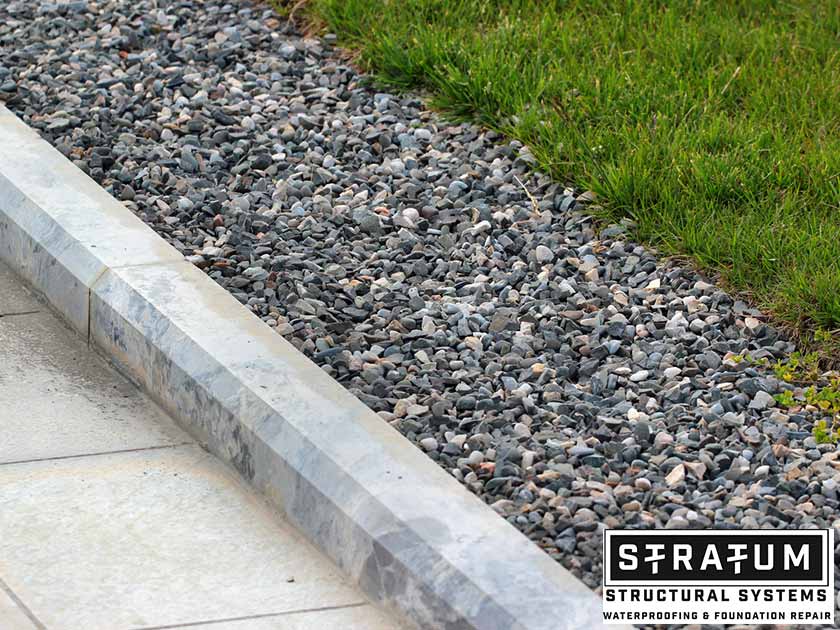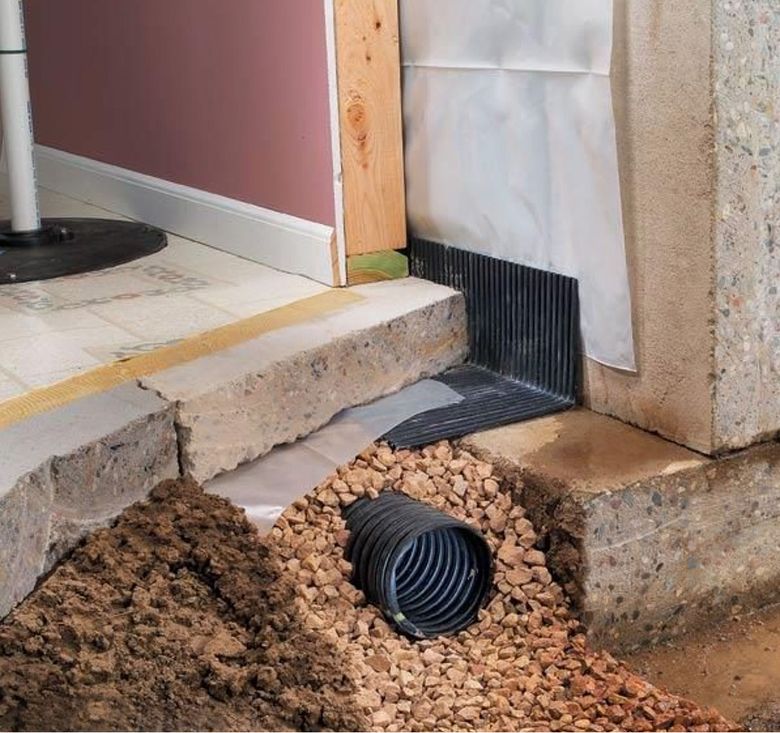Just How a French Drainpipe Can Aid Prevent Water Damage in Your Basement
A French drainpipe could be the service you need if you're dealing with a wet cellar. This system efficiently redirects water far from your foundation, aiding to avoid expensive damages. Recognizing how it works and recognizing the signs that you need one can make a substantial distinction in your house's safety and comfort. Prior to you make a decision, it's crucial to explore the benefits and installation process to see if it's the best fit for your situation.
What Is a French Drain?
A French drainpipe is a straightforward yet reliable remedy for taking care of excess water around your building. It's made to reroute water away from vulnerable areas, like your basement or structure. Commonly, it is composed of a trench loaded with crushed rock and a perforated pipeline that gathers and networks water. When rain or groundwater accumulates, the drainpipe effectively overviews it away, protecting against potential damage.You might notice French drains pipes mounted along building lines, driveways, and even near your home's foundation. They come in various dimensions and setups, making them adaptable to various landscapes and water drainage requirements. Installing a French drainpipe can assist you stay clear of pricey repair services and secure your home's structural honesty. A French drain could be the remedy you require if you've been dealing with water pooling or soggy locations in your yard. It's a positive action to ensure your home remains secure and dry from water-related concerns.
Exactly how Does a French Drain Work?
A French drain kicks right into action to reroute it properly when water accumulates around your residential or commercial property. This system contains a trench full of crushed rock and a perforated pipe at the bottom. The pipe collects excess water from the dirt and channels it far from your foundation.As rainwater or groundwater seeps into the crushed rock, it streams via the openings and right into the pipe. Gravity does the work, drawing the water far from your basement and guiding it to a marked drainage location, like a storm drain or completely dry well.You can install a French drain either inside or outside your home. If you select an outside setup, it'll avoid water from merging near your foundation. An interior drainpipe will catch water that permeates through your cellar walls. This efficient layout maintains your room dry, allowing you to enjoy your home without the concern of water damages.
Advantages of Mounting a French Drainpipe
Installing a French drain can considerably improve your home's resilience against water damage. You'll appreciate reliable water diversion, which helps in reducing mold growth and safeguard your residential property. And also, a well-maintained drainage system can also boost your residential or commercial property's value.
Effective Water Diversion

Decreased Mold And Mildew Development
Given that dampness produces a best atmosphere for mold to thrive, decreasing water accumulation around your home is critical for maintaining a healthy and balanced space. Mounting a French drainpipe properly channels excess water far from your foundation, keeping your cellar completely dry. This proactive measure greatly lowers humidity levels, making it harder for mold spores to resolve and grow.With much less wetness, you'll locate it much easier to breathe and enjoy a clean, risk-free environment. And also, you'll minimize the risk of wellness problems related to mold direct exposure, such as allergic reactions and respiratory system issues. By buying a French drainpipe, you're taking a necessary step towards a mold-free basement, guaranteeing that your home remains a comfy location for you and your family members.
Boosted Home Worth
A French drainpipe can considerably boost your residential or commercial property's worth, making it a smart financial investment for property owners. When possible buyers see a properly maintained cellar without water damages, they're most likely to be pleased. This feature not only boosts your home's appeal however also indicates that you have actually taken aggressive steps to secure it. By reducing the threat of water-related issues, your property ends up being extra attractive in an open market, commonly leading to higher offers. In addition, the long-lasting cost savings on fixings and maintenance can translate into boosted equity. Mounting a French drainpipe reveals you care regarding your home's honesty, reassuring buyers that they're making a sound purchase. Eventually, it's a useful enhancement that repays in even more methods than one.
Indicators You Required a French Drainpipe
It's a clear indication that you might require a French drainpipe if you see persistent water build-up in your lawn or cellar. Additionally, a stuffy smell can show trapped dampness, which can bring about larger problems. Resolving these signs early can help prevent significant water damages to your home.
Consistent Water Build-up
When you discover relentless water buildup around your home, it's a clear indication that a French drain may be needed. Water pooling near your structure can cause significant damages in time, including structural problems and mold development. You ought to pay interest to areas where water appears to gather after hefty rains or snowmelt. If your lawn stays soaked for days, it's time to do something about it. In addition, search for signs of erosion or sloppy patches, as these can show bad drainage. Mounting a French drain assists reroute water away from your home, shielding your foundation and lowering the risk of water damages. Do not wait on larger issues to occur-- addressing water build-up now can conserve you expensive repair work later on.
Musty Odor Visibility
Persistent water build-up often causes greater than simply visible pooling; it can produce an environment ripe for mildewy smells. If you notice a moist, stale odor in your basement, it's an indication that dampness is lingering, typically as a result of poor drainage. This odor normally shows mold or mold development, which can position health and wellness go to this site threats and harm your possessions. You may discover that the odor aggravates throughout moist weather or after heavy rains. If you're battling consistent moldy odors, it's time to examine a French drainpipe. This system reroutes water away from your foundation, minimizing moisture levels and combating those unpleasant scents. Do not neglect this caution indicator; resolving it quickly can conserve you from a lot more extensive water damages down the line.
The Installment Refine of a French Drainpipe
Setting up a French drain can be a simple process that significantly boosts your home's water damage prevention. Initially, review the area where you intend to mount the drain, ensuring it slopes away from your structure. Next, mark the trench's path, which should have to do with 6-8 inches wide and 18-24 inches deep.Excavate the trench, getting rid of soil as required. Portland French Drain. Lay down landscape textile to stop soil from obstructing the drain once you have actually got your trench. After that, add a layer of crushed rock at the base. Place a perforated pipeline on top of the crushed rock, making sure the holes encounter downward for effective drainage.Cover the pipeline with even more gravel, leaving concerning 3 inches of space on top. Fold the landscape textile over the gravel to protect it. Fill in the trench with soil, condensing it as you go. You've now established a dependable system to reroute water away from your cellar!
Maintenance Tips for Your French Drainpipe
A French drainpipe is designed to effectively take care of water flow, normal upkeep is vital to validate its continued efficiency. Beginning by checking the drainpipe and its surroundings for debris or clogs. Clear any kind of leaves, dirt, or sediment that might accumulate, specifically after heavy rains.Next, inspect the outlet for proper drain. It should guide water away from your structure-- if it does not, you might require to adjust its setting. Furthermore, verify that the crushed rock surrounding the drainpipe is intact and hasn't worked out over time; this aids maintain appropriate water flow.Consider scheduling an annual specialist examination to capture any concerns early. Resolve them immediately to prevent bigger troubles down the roadway if you see any type of indications of water damage or pooling. With a little attention, your French drainpipe can properly protect your basement for many years to find.
Cost Considerations and Long-Term Savings
When considering a French drainpipe, it's vital to evaluate both the preliminary investment and the lasting financial savings it can supply. While the ahead of time expense might seem significant, consider it as a financial investment in your home's future. Installing a French drainpipe typically ranges from $1,500 to $5,500, depending upon your basement's dimension and the intricacy of the installation.However, this cost can conserve you thousands in prospective water damage, mold and mildew removal, and foundation repair work. By avoiding water accumulation, you're also securing your home's value and staying clear of pricey insurance policy claims. Additionally, a completely dry basement can lower your power expenses, as dampness can cause enhanced cooling and heating costs. Inevitably, the comfort that includes knowing your home is guarded from water damage is invaluable. Think about these factors very carefully to make a well-informed decision that benefits you over time.

Frequently Asked Questions
Can a French Drainpipe Be Mounted in Any Type Of Type of Soil?
Yes, a French drainpipe can be installed in various dirt types, including sand, loam, and clay. Nevertheless, proper installment and drain planning are important to guarantee it operates efficiently in your specific dirt conditions.
The length of time Does a French Drain Last Prior To Needing Substitute?
A French drain commonly lasts around 30 to 40 years with appropriate installation and maintenance. Factors like soil kind and water flow can impact its life-span, so keep an eye on its efficiency.
Can French Drains Pipes Help With Lawn Water Drainage Issues?
Yes, French drains can successfully address lawn water drainage issues. They guide excess water far from trouble areas, preventing merging and guaranteeing your landscape remains healthy. Installing one can greatly improve your lawn's total water drainage performance.
Will a French Drain Impact My Landscape Design or Yard?
A French drain can influence your landscape design or garden, especially if it's set up incorrectly. You'll intend to make sure it's placed tactically to lessen additional hints disturbance, maintaining your plants and general aesthetic while enhancing water drainage.
Exist Alternatives to French Drainpipes for Cellar Water Concerns?
Yes, there are alternatives to French drains for basement water issues. You might consider sump pumps, waterproof finishings, or rating your lawn to reroute water away. Each Go Here choice has its advantages, so examine what fits your requirements best. When rainwater or groundwater develops up, the drain effectively guides it away, avoiding possible damage.You could see French drains pipes mounted along property lines, driveways, or even near your home's structure. Gravity does the job, drawing the water away from your basement and directing it to a marked drainage location, like a tornado drain or dry well.You can install a French drainpipe either inside or outside your home. By successfully transporting water away from your residential property, a French drainpipe can significantly decrease the risk of water damage. Installing a French drainpipe aids redirect water away from your home, protecting your structure and minimizing the danger of water damage. Mounting a French drain can be a straightforward process that substantially enhances your home's water damages prevention.